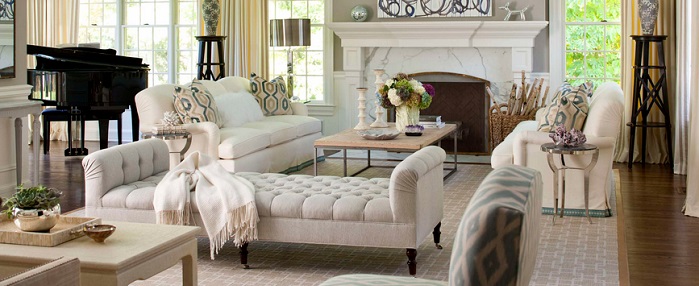Usually when we talk about conversation furniture, we’re referring to a set. That is, a few chairs, benches, or small sofas for an indoor or outdoor gathering space. But today I want to take a look at conversation chairs specifically. These are a bit of a relic: chairs designed with two seats, that allow two sitters to speak comfortably face to face…with no danger of their legs touching, thanks to the arm in between the two seats. A testament to Victorian modesty, tete-a-tete or vis-a-vis chairs are a little baffling to the modern eye. But they make for a brilliant statement piece – and, if you’ll allow it, are a great conversation starter.
Why In The World Would They Make Chairs Like This?
The purpose of the original tete-a-tete chairs was simple: to allow courting couples a degree of intimacy and closeness while maintaining at least a token amount of modesty and decorum. (Though they’re also often called “kissing chairs,” because they bring two people’s faces quite close together!). Rather than sitting side by side on a conventional loveseat where some accidental (or on purpose) leg touching might occur, S-shaped conversation chairs make it possible for two people to have a private conversation in a public space, while keeping their hands very clearly to themselves.
Alright, I’ll Bite: Why Would I Want One?
Now, I suspect a few parents of lovelorn teenagers have already clicked through to see what we have in stock. But for the rest of you, a tete-a-tete might seem like a strange thing add to your living room. And, certainly, you wouldn’t want one as your main or only form of seating. But conversation chairs make surprisingly good transitional pieces, especially in a room with an open floorplan. If you have multiple seating areas, a tete-a-tete can serve the rooms on both sides without feeling awkward in either. It makes a great alternative to the usual suspect: a sofa with a sofa table behind it.
In fact, different conversation chair configurations are often used this way in large spaces that are meant to be inviting, like lobbies of upscale hotels. Round, three seat (or more, depending on the size) conversation chairs are a great example. They’re easy to walk around or past, facilitate conversation between people who sit next to each other, while also affording them a level of privacy from people who sit near by on larger seats. In your home, this same design can occupy awkward spaces, turning them into statement pieces and inviting family and friends to sit and engage with each other, or with people in the part of the room they’re facing. Perfect for a soft division between different parts of a great room!
Will It Get Any Use?
Now, I can’t guarantee that a conversation chair will be the new most fought-over chair in your house. But I suspect you’ll find that they’re actually more comfortable (and therefore usable) than most rigid, overly-firm antique replicas that are typically used as accent furniture. Larger tete-a-tete chairs are big enough to let you recline. Honestly, I haven’t seen a better setup for two people who want to have a long face-to-face conversation. Even if you don’t have teens to put in them, chairs that might be a little small for an adult? Make exceptionally good “get along” chairs for younger kids.
How Big Are Conversation Chairs?
Tete-a-tete chairs range in size from barely big enough for two small-bottomed people to big enough for a hotel lobby. The size you want will depend mostly on where you want to put it. If you want to use them as a room divider, bigger is generally better. I’d look for something close to two side-by-side arm chairs if you want to use it to separate two seating areas. Round shapes are ideal for filling up awkward void spaces (think, a roundabout for the empty part of your living room). But they’re probably bigger than you want if your greatroom is already short on space. Very small conversation chairs can struggle to hold their own in a large space; but they make a fun alternative to a vanity stool or garden bench where you might like to have someone join you back-to-back.
Find The Right Style For Your Space

What I find really exciting about conversation chairs is that despite the fact that they’re very clearly a relic from a specific cultural moment, that hasn’t stopped them from evolving into a lot of fun different styles. While you can certainly find them with solidly antique, Victorian styles and trappings, it’s not hard to find similar designs with a more modern twist, from Hollywood glam to colorful, avant-garde replicas. And while they may not have quite the same panache, if you like the idea of using one in your greatroom, backless chaises, benches, or even daybeds can give you similar functionality with a more contemporary aesthetic.
They say everything comes around again. Conversation chairs may have outlived their original intended purpose. But they’re a great tool to have in the kit if you want to reassess and reinvent your barrier-free spaces. So if you’re looking for a new accent chair, don’t just settle for one that’ll get people talking… Get one you can sit down and have a conversation in, too!






